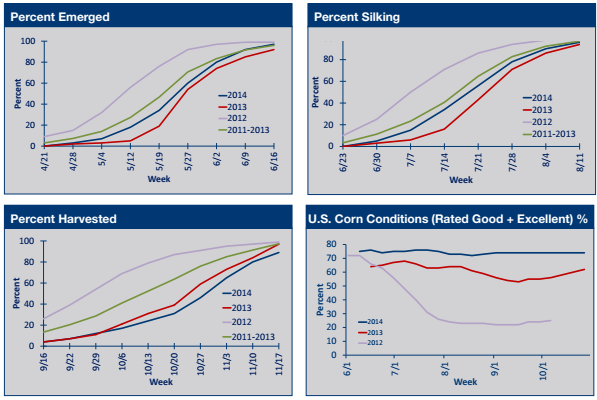D.Comparison of 2014 to 2013, 2012, and the Three-Year Average
2014 was cool like 2013, but had more rain and record yields
In contrast to the very dry spring of 2012 with early planting, 2014 had delayed average planting, due to cold, wet conditions. However, by mid-May, the majority of planting was similar to 3YA, and about a week earlier than in 2013. The vegetative growth rate and silking time of 2014 was similar to 3YA, in contrast to the early silking time of the hot, dry 2012, and the delayed stage in 2013. This silking and pollination time of 2014 extended for a longer duration than 2013. Additionally, in a majority of the corn-growing region, the rains tapered off, allowing for a greater number of kernels to be pollinated, establishing the potential for record yields.
Similar to 2013, the summer of 2014 was cooler than 3YA, and much cooler than the drought of 2012. In contrast to the temporary drought of 2013, the summer of 2014 had ample rain and more soil moisture, promoting more grain, yield, and oil, but less protein. Harvest in both 2014 and 2013 was later than 3YA due to multiple weeks of rain and freezing temperatures.
Throughout much of 2014, the corn crop had the greatest Good + Excellent condition percentage compared to the past 10 years, signifying good plant health, leading to greater photosynthesis, starch accumulation and yield. In contrast, the corn crop in 2013 was rated better than 3YA, but less than 2014, due to the short-term intense heat and drought. The severity of the drought and heat wave in 2012 rapidly decreased the crop condition, starch accumulation, and yield, but increased grain test weight and protein concentration.
2A “Good” rating means that yield prospects are normal. Moisture levels are adequate and disease, insect damage, and weed pressures are minor. An “Excellent” rating means that yield prospects are above normal, and the crop is experiencing little or no stress. Disease, insect damage, and weed pressures are insignificant.
